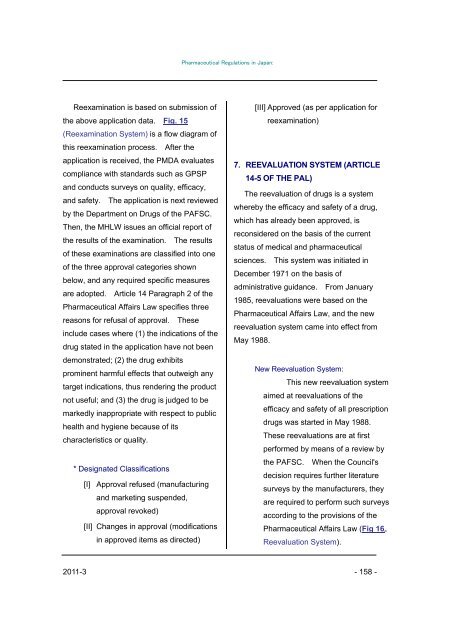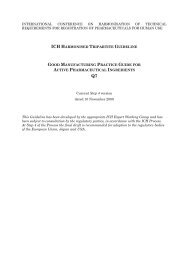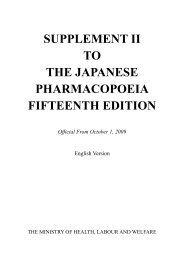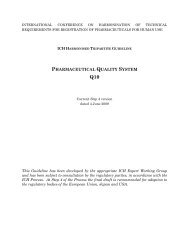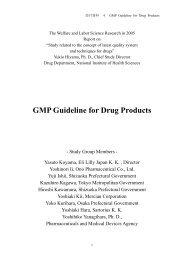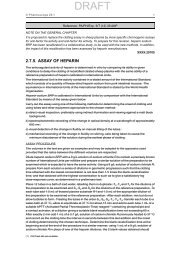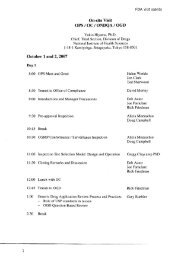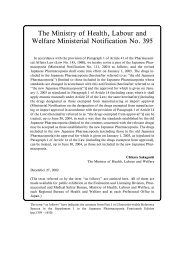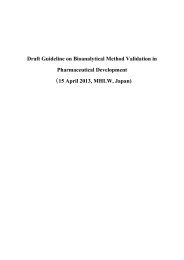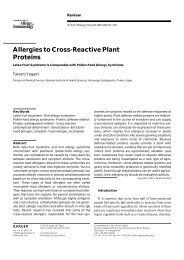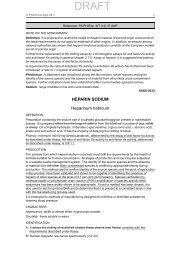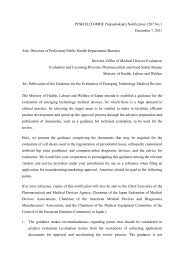Pharmaceutical Administration and Regulations in Japan - Nihs
Pharmaceutical Administration and Regulations in Japan - Nihs
Pharmaceutical Administration and Regulations in Japan - Nihs
Create successful ePaper yourself
Turn your PDF publications into a flip-book with our unique Google optimized e-Paper software.
Reexam<strong>in</strong>ation is based on submission of<br />
the above application data. Fig. 15<br />
(Reexam<strong>in</strong>ation System) is a flow diagram of<br />
this reexam<strong>in</strong>ation process. After the<br />
application is received, the PMDA evaluates<br />
compliance with st<strong>and</strong>ards such as GPSP<br />
<strong>and</strong> conducts surveys on quality, efficacy,<br />
<strong>and</strong> safety. The application is next reviewed<br />
by the Department on Drugs of the PAFSC.<br />
Then, the MHLW issues an official report of<br />
the results of the exam<strong>in</strong>ation. The results<br />
of these exam<strong>in</strong>ations are classified <strong>in</strong>to one<br />
of the three approval categories shown<br />
below, <strong>and</strong> any required specific measures<br />
are adopted. Article 14 Paragraph 2 of the<br />
<strong>Pharmaceutical</strong> Affairs Law specifies three<br />
reasons for refusal of approval. These<br />
<strong>in</strong>clude cases where (1) the <strong>in</strong>dications of the<br />
drug stated <strong>in</strong> the application have not been<br />
demonstrated; (2) the drug exhibits<br />
prom<strong>in</strong>ent harmful effects that outweigh any<br />
target <strong>in</strong>dications, thus render<strong>in</strong>g the product<br />
not useful; <strong>and</strong> (3) the drug is judged to be<br />
markedly <strong>in</strong>appropriate with respect to public<br />
health <strong>and</strong> hygiene because of its<br />
characteristics or quality.<br />
* Designated Classifications<br />
[I] Approval refused (manufactur<strong>in</strong>g<br />
<strong>and</strong> market<strong>in</strong>g suspended,<br />
approval revoked)<br />
[II] Changes <strong>in</strong> approval (modifications<br />
<strong>in</strong> approved items as directed)<br />
<strong>Pharmaceutical</strong> <strong>Regulations</strong> <strong>in</strong> <strong>Japan</strong>:<br />
[III] Approved (as per application for<br />
reexam<strong>in</strong>ation)<br />
7. REEVALUATION SYSTEM (ARTICLE<br />
14-5 OF THE PAL)<br />
The reevaluation of drugs is a system<br />
whereby the efficacy <strong>and</strong> safety of a drug,<br />
which has already been approved, is<br />
reconsidered on the basis of the current<br />
status of medical <strong>and</strong> pharmaceutical<br />
sciences. This system was <strong>in</strong>itiated <strong>in</strong><br />
December 1971 on the basis of<br />
adm<strong>in</strong>istrative guidance. From January<br />
1985, reevaluations were based on the<br />
<strong>Pharmaceutical</strong> Affairs Law, <strong>and</strong> the new<br />
reevaluation system came <strong>in</strong>to effect from<br />
May 1988.<br />
New Reevaluation System:<br />
This new reevaluation system<br />
aimed at reevaluations of the<br />
efficacy <strong>and</strong> safety of all prescription<br />
drugs was started <strong>in</strong> May 1988.<br />
These reevaluations are at first<br />
performed by means of a review by<br />
the PAFSC. When the Council's<br />
decision requires further literature<br />
surveys by the manufacturers, they<br />
are required to perform such surveys<br />
accord<strong>in</strong>g to the provisions of the<br />
<strong>Pharmaceutical</strong> Affairs Law (Fig 16。<br />
Reevaluation System).<br />
2011-3 - 158 -


